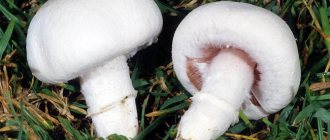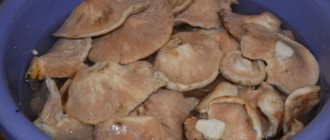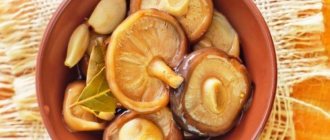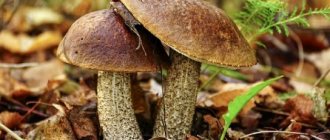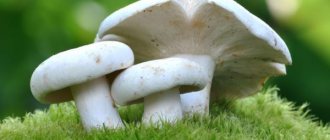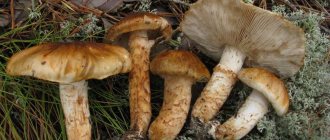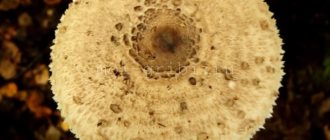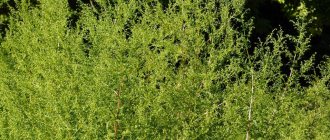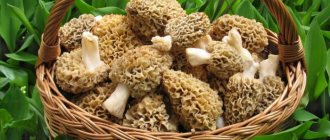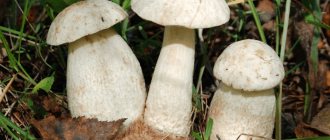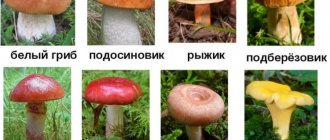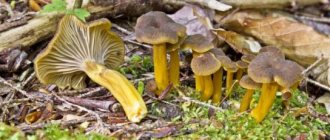Russula mushrooms
The name of the genus of Russula mushrooms is translated from Latin as “reddish”; the genus includes more than sixty species of various colors - from red, brown, green to yellow and white. Mushrooms are elegant and undemanding - they grow on various soils in dry and damp cold weather. They have brittle white flesh and light-colored plates. Contrary to the sonorous name, the fruiting bodies are not eaten raw, and many of them have a bitter taste.
Young russulas are collected together with their stems and carefully placed in baskets on a layer of leaves or moss - fragile mushrooms are difficult to bring home intact. They are suitable for preparing various main courses and homemade pickles.
Types of Russula
Green russula
Green russula
This beautiful, strong mushroom is found in oak and birch forests, where it grows alone or forms small mushroom clearings. The cap is wide, first round, then spread out, up to 18 cm in diameter. The skin is greenish, pale, brownish-green in the center, easily removed.
The leg is dense, 8–10 cm high, light cream, smooth, without thickening at the base and without a ring on the leg. The pulp is white, brittle, with creamy thin plates attached to the stem, neutral taste, without bitterness.
Russula wavy
Russula wavy
A common species that grows in deciduous and coniferous forests, it is noticeable from afar thanks to the bright red tones of the glossy cap - red-burgundy in the center and slightly lighter at the edges. Depending on the place of growth, shades can vary - from lilac-red to crimson and pink.
The cap is hemispherical, up to 6–10 cm in diameter, in old mushrooms it is spread out, while the edges remain curved and slightly wavy. The plates are thin, frequent, milky white. The pulp is strong, slightly pink at the break from the cap, neutral in taste or slightly bitter. The leg has a regular cylindrical shape, creamy white color, and in dry weather it takes on a pink tint.
Russula food
Russula food
In pine forests on sandy soil you can find these tasty mushrooms with a rounded hemispherical cap, which later becomes slightly convex or flat, and then completely concave in the middle. The skin is light red, may have shades of purple, beige or pink, slightly puffy at the edges and is easily removed. The plates are numerous, milky white, then cream.
The leg is dense, thick, white, up to 7 cm high, brownish at the base, and in dry weather takes on the color of a cap. The pulp is pleasant to the taste, without bitterness, with a mild aroma of pine nuts.
Marsh russula mushroom (with photo)
Russula marsh mushroom in the photo
The marsh russula mushroom is edible, its cap is 6-15 cm, at an early age it is convex, with a tucked edge, later open or concave in the middle, smooth, bright, red, strawberry color. The plates are white, then the color of butter. The leg is white or with a reddish tint, 5-12 cm long, 1-3 cm thick. Pulp with a mild taste. The pulp is not fibrous, fragile, and when broken it looks as if it were assembled from small crystals. The milky juice is neither white nor transparent. Ocher spore powder.
Grows in acidic soils, peat bogs, under spruce or pine. It is easy to find by its bright color.
Look at this russula mushroom in the photo that illustrates its appearance:
Fruits from July to October.
The marsh russula differs from the red fly agaric (Amanita muscaria) in the absence of a ring and volva, and a fragile, non-fibrous stalk.
Places of distribution and time of collection
The most delicious species, the russula, lives in deciduous or mixed lowland forests under beech, oak and birch trees. The collection time extends from the beginning of June until the end of August. The common type is valued above others for its pleasant taste, nutty aroma and dense pulp.
Russula wavy is collected from late summer to mid-October and is found in mixed and deciduous forests, on plains and in mountainous areas. The species forms fairly strong, dense fruiting bodies, and therefore is loved by mushroom pickers no less than the previous one.
Green russula often grows under birch trees, forming mycorrhizae with these trees, as well as in light oak forests. The harvest season is in late summer and September. And even in warm October you can come across entire clearings of greenish mushrooms.
The fragile caps, not having time to emerge from the ground, quickly open, attracting hordes of insects to the appetizing pulp. Old specimens are especially fragile and, when collecting them, you can bring home a basket of mushroom crumbs.
Experienced mushroom pickers take only the tight fruiting bodies of young mushrooms, carefully placing them in a basket. They are cut off together with the leg, which is suitable for food, and at the same time checked for worms.
What kind of russula mushrooms are wine red?
Wine-red russula mushrooms in the photo
What wine-red russula mushrooms are known to botanists and can be eaten? The mushroom is edible. The cap is 5-12 cm, convex at an early age, with a tucked edge, later from open to concave in the middle, smooth, bright, brown-red or wine-red. The plates are whitish, light ocher. The leg is white, with a purple tint, 5-9 cm long, 1-2 cm thick. The pulp has a mild taste and turns gray when cut. The pulp is not fibrous, fragile, and when broken it looks as if it were assembled from small crystals. The milky juice is neither white nor transparent. Spore powder is light creamy.
Grows in damp forests, on peat bogs, under spruce or pine.
Fruits from July to October.
The wine-red russula differs from the red fly agaric (Amanita muscaria) in the absence of a ring and volva, and a fragile, non-fibrous stalk.
False russula
The eye-catching colored russulas are not considered the best mushrooms, but are still collected en masse due to their availability and lucky ability to grow everywhere. Their disadvantages are not only fragility, blandness of taste, and the presence of some bitterness, but due to their external diversity they have very dangerous doubles.
Death cap
Death cap
One of the most dangerous mushrooms, the deadly poisonous toadstool, looks like green russula. A greenish glossy cap, up to 15 cm in diameter, frequent white plastics and a neutral taste - these are the main similarities of these species.
The characteristic differences of the pale grebe are a wide and then fringed ring on the leg and a thickened cup-shaped base, a kind of “bag” near the ground. Often in old toadstools the ring disappears and therefore you need to remain vigilant, and if in any doubt, beware and not take a suspicious mushroom at all.
Russula is caustic (burning)
Russula is caustic (burning)
The convex caps of light red or pinkish color are easily confused with the also colored russula and wavy russula. The fragile pulp is white, turning pink closer to the skin, with a light fruity aroma and a pungent, unpleasant taste.
This species is not as dangerous as the previous one, and some mushroom pickers even use delicious-looking mushrooms for food, after boiling them for at least half an hour. At the same time, scientists discovered in the tissues the toxic substance muscarine, which is part of the fly agaric and causes severe poisoning. For this reason, this species cannot be considered edible.
Russula acute (yellowing)
Russula acute (yellowing)
An attractive mushroom with a dense, smooth cap of cherry or red-brown color and a purple tint, similar to wavy russula. The pulp is firm, yellowish, with a fruity aroma, becoming yellow closer to the skin. The taste is unpleasant, acrid. The peel is difficult to remove. Leg with violet or mauve tint.
It grows mostly in coniferous forests, forming mycorrhiza with pine. It is not considered edible due to its bitterness and, when eaten raw, causes digestive problems.
Russula blood red
Russula blood red
In coniferous and mixed forests, more often under pine trees, you can find these eye-catching blood-red mushrooms. The cap is up to 10 cm in diameter, at first convex, later widely spread, wine-red in color, sometimes with a lilac tint. The peel is difficult to remove.
The pulp is white, reddish near the skin, bitter or acrid to varying degrees, in the stem with a sweet aftertaste, fruity aroma. The species is inedible due to its bitterness and can cause indigestion when eaten raw.
Characteristics
If you look at it from a scientific point of view, russula is a whole genus of mushrooms, including different species.
And each of them has its own unique properties and characteristics, however, for the entire genus there are distinctive features by which you can determine that you have found a russula and not some other mushroom:
Hat. At the initial stage of growth it is spherical. Then it opens up and forms a flat umbrella.
Records. All representatives of this genus have plates under the cap. If you find a mushroom with a spongy cap, then it is definitely not a russula.
Leg. In most cases it is smooth and fragile. Although in some species the leg is thick and crooked, it is relatively strong.
Coloring. The color of the mushroom is camouflage - this is how the russula tries to camouflage itself from animals that are potentially dangerous to it. The color of the cap and stem varies among different species.
But most often the color of the mushroom is purple, red, orange, gray, blue or marsh. All color options can be seen in more detail in the photographs of russula.
Beneficial features
Russula is a storehouse of valuable substances, vitamins and microelements. More than 20% crude protein is found in the tissues, which is almost twice as much as in most vegetables. From the fleshy, dense pulp you can prepare nutritious lean dishes, partially replacing meat and fish products. The tissues of russula contain the most important mineral elements for the body - calcium and phosphorus, magnesium and iron.
Red and purple mushrooms have an antibacterial effect and are used in folk medicine to treat abscesses and pyoderma.
An enzyme was found in the red-colored species, which scientists named russulin, after the Latin name of this genus of mushrooms. The enzyme has powerful activity and, in small quantities, can quickly curdle milk, replacing rennet enzymes in cheese production.
Russula mushroom varieties: brown
Russula brown in the photo
These varieties of russula mushrooms are edible: the cap is 6-15 cm, convex at an early age, with a tucked edge, later from open to concave in the middle, smooth, ocher-brown or nut-brown. The plates are whitish, creamy yellow with brown spots. The leg is white, grey, 4-8 cm long, 1-3 cm thick. The pulp has a mild taste, the flesh in the cap is white with a brown tint. The pulp is not fibrous, fragile, and when broken it looks like small crystals. The milky juice is neither white nor transparent. Spore powder is creamy.
Russula brown grows in coniferous and mixed forests under spruce.
Fruits from July to October.
Russula brown differs from yellow fly agarics in the absence of a ring and volva, and a fragile, non-fibrous stalk.
Contraindications for use
Many species have some bitterness and, when raw or undercooked, can cause digestive disorders, and russula stinging, which is also called nauseating, provokes vomiting and severe irritation of the mucous membranes.
Mushrooms are not recommended for food for people with gastrointestinal diseases. Marinated mushroom preparations and fried foods in large quantities put a strain on the liver, especially with gallbladder pathologies. Therefore, such foods are eaten in moderation and with caution.
You should not include russula in the diet of children under six years of age - this is a heavy food for them, requiring the active work of enzymes, the production of which is still insufficient in the child’s body.
It would be useful to remind you of the enormous danger that threatens the unlucky mushroom picker, who can confuse russula with poisonous mushrooms, especially with toadstool.
Green mushroom of the genus Russula
The green russula mushroom is edible. The cap is 5-10 cm, convex at an early age, with a tucked edge, later from open to concave in the middle, smooth, bright, grass-green or olive-green. The plates are whitish or the color of butter; when damaged and in old age, rusty brown spots appear. The leg is white, rusty at the bottom, 5-8 cm long, 1-2 cm thick. The pulp has a slightly pungent taste, is not fibrous, fragile, and when broken it looks as if it were assembled from small crystals. The milky juice is neither white nor transparent. Spore powder is light ocher.
This green mushroom of the russula genus grows in deciduous, mixed and coniferous forests, under birch, spruce or pine.
Fruits from June to October.
The green russula differs from the pale grebe (Amanita phalliodes) in the absence of a ring and volva, and a fragile, non-fibrous stalk.
Recipes for cooking dishes and preparations
Recipes for cooking dishes from russula
Before cooking, wash the mushrooms thoroughly, then quickly peel them by lifting the skin from the edges and lightly cutting out the middle. The peeled fruiting bodies are immediately processed, preventing darkening. They are suitable for any preparations and dishes, except first courses.
Natural russula
They use species without bitterness - edible and green russula. After initial processing, they are boiled in acidified and salted water at the rate of 40 g of salt and 10 g of citric acid per 2 liters of water. It should be taken into account that during cooking they will shrink significantly, decreasing in volume, and at the end of cooking they will sink to the bottom.
After boiling the mushrooms for 20 minutes, they are placed in jars and filled with boiling broth, after which they are sterilized for at least an hour and a half. The product is then sealed, cooled and stored in a cold place.
Russula in hot salting
This healthy spicy pickle is one of the best mushroom preparations. For 2 kg of mushrooms you will need 4 tablespoons of salt, 2 bay leaves, 6 black peppercorns, 4 black currant leaves, a little cloves and dill seeds.
Pour 1 glass of water into a bowl, add salt and bring to a boil. Mushrooms are immersed in boiling brine, the foam is removed, after full boiling, spices are added and simmered over low heat for 15 minutes. Readiness can be determined by the settling of the pieces to the bottom and the lightening of the brine. The workpiece is cooled and placed in jars, filled with brine and closed. The pickle is ready in a month and a half.
Russulas fried in breadcrumbs
Large caps of species without bitterness are peeled, cut into halves, salted, dipped in egg, breaded in flour and sprinkled with breadcrumbs. The pieces are fried in a large amount of boiling vegetable oil.
Place the workpiece in half-liter jars 1 cm below the neck and sterilize for one hour. Then seal, cool and store in a cool place.
Mushroom caviar
Thoroughly washed and cleaned fruit bodies are boiled for 30 minutes, constantly skimming off the foam, then placed on a sieve and placed in a porous canvas bag under pressure for 4 hours to drain excess liquid.
The mushrooms pressed in this way are finely chopped or ground in a meat grinder with a large grid together with a small head of onion, add 50 g of salt per 1 kg of mushrooms and ground black pepper. The resulting caviar is placed in sterile jars, filled with boiled oil and covered with clean, dry lids. The food is stored for a short time, about one month, in the refrigerator.
Video about russula mushrooms.
Elegant colored russula grow everywhere - in pine and deciduous forests, in clearings and forest edges, in the grass near white-trunked birches. Almost a third of all collected mushrooms belong to one or another species of Russolaceae. With their unpretentiousness, accessibility, bright colors and ease of preparation, they attract mushroom pickers who are in no hurry to bypass these wonderfully healthy and satisfying gifts of the forest.
Video about russula mushrooms
Elegant colored russula grow everywhere - in pine and deciduous forests, in clearings and forest edges, in the grass near white-trunked birches. Almost a third of all collected mushrooms belong to one or another species of Russolaceae. With their unpretentiousness, accessibility, bright colors and ease of preparation, they attract mushroom pickers who are in no hurry to bypass these wonderfully healthy and satisfying gifts of the forest.
The description of the russula mushroom is known to everyone who is interested in quiet hunting in the forest. This is the most common prey for mushroom pickers. There are different types of russula mushrooms, which essentially differ from each other only in the color of the upper surface of the cap. All varieties of russula can be eaten raw without harm to health. This is where their name comes from.
Look at this page for a description of the russula mushroom with photos and get acquainted with the most popular types and varieties.
What to do if you are poisoned by poisonous russula
In case of poisoning by false russula, the victim is given first aid. First of all, it is necessary to remove dangerous substances from the body. To do this, do a gastric lavage and take sorbents. Be sure to call an ambulance. In case of severe intoxication, treatment is carried out in a hospital under the supervision of a doctor.
Before the doctor arrives, the patient is given first aid:
- give more warm liquid;
- induce vomiting to empty the stomach;
- take activated carbon, Polysorb or similar drugs;
- the victim is provided with bed rest.
Treatment of poisoning after eating false mushrooms takes several days. In severe cases, this process lasts for weeks. Following a diet helps speed up the recovery of the body. Heavy foods are excluded from the diet. You should also drink more liquids: herbal tea or infusions.
What does the pungent russula mushroom look like (with photo)
Russula is hot and caustic in the photo
Mushrooms are inedible. You need to know what the pungent russula mushroom looks like: the cap is 5-9 cm, convex at an early age, with a tucked edge, later open or concave in the middle, smooth, bright, pink, light red. The plates are adherent, white, yellowish in old mushrooms. The leg is white, grey, 5-9 cm long, 1-2 cm thick. The flesh of the leg is white, the cap is pinkish, with a bitter, burning taste, and a fruity smell. The pulp is not fibrous, fragile, and when broken it looks as if it were assembled from small crystals. The milky juice is neither white nor transparent.
Grows in damp forests, on peat bogs, under birch, alder or pine.
Fruits from July to October.
Look at what the pungent russula mushroom looks like in the photo and remember that you shouldn’t take it into your basket:
Can be confused with edible marsh russula.
Russulas are the most common mushrooms in Russian forests. Russula accounts for 30 to 45% of the total volume of mushrooms in forests.
Russulas are quite appetizing and tasty. Some varieties are eaten even raw (hence the name russula). But among them there are both edible and inedible species. Inedible are those species that have a very bitter taste, which does not disappear even after preliminary soaking of the fruiting bodies.
In today's publication you will learn how to distinguish edible and inedible russula and see photos of each type.
How to distinguish edible and inedible russula
Russulas are the most common mushrooms in Russian forests. Russula accounts for 30 to 45% of the total volume of mushrooms in forests.
Russulas are quite appetizing and tasty. Some varieties are eaten even raw (hence the name russula). But among them there are both edible and inedible species. Inedible are those species that have a very bitter taste, which does not disappear even after preliminary soaking of the fruiting bodies.
In today's publication you will learn how to distinguish edible and inedible russula and see photos of each type.
General description of russula
Their cap is spherical or hemispherical in shape. As the fruiting body ages, it takes on an open appearance and becomes flat. Some species have a characteristic funnel in the central part.
The color of the hat can be varied. Potipuona can be dry, damp, matte or cracking.
The leg is cylindrical, less often it is perfectly flat. Inside it can be both empty and dense.
The pulp is of good density, quite fragile, spongy type. Upon contact with oxygen, it often changes its color to gray, brown, black, or red.
The first russulas grow in July, and reach their peak fruiting at the end of summer. They mostly prefer to live under deciduous trees.
Edible species
The following types are edible:
- Bolotnaya.
- Turning brown.
- Yellow.
- Green-red.
- Golden.
- Brittle.
- Laurel cherry or almond.
- Morse.
- Graying.
- Blue-yellow.
- Azure, or blue.
- Turkish.
- Wonderful, or flawless.
- Greenish.
Let's talk about each one separately.
Bolotnaya
Most often, floaters (as people call the swamp) grow in coniferous forests. The peak activity of this fungus is observed in the summer and autumn months. Fruiting lasts until the first month of autumn. The diameter of the float cap varies in the range of 5-15 cm in diameter.
Browning
This species stands out among others in that it has an intense aroma of unprocessed herring. However, the smell does not affect the taste. After cooking the fruit body, the specific aroma of the herring disappears. This species itself is small; the cap grows to a maximum of 8 cm in diameter.
Yellow
Yellow is classified as an edible species of the 3rd category. It has good taste, but is less valued by mushroom pickers than its other species. Most often it is pickled. The yellow cap grows up to 12 cm in diameter.
Green-red
It is classified in the 3rd category. It has a very pleasant taste and does not require long-term heat treatment; it is enough to boil the fruit body for about 5-10 minutes in salted water. Its overall caps vary from 5 to 20 cm in diameter.
Golden
Despite its wide distribution (this mushroom is common throughout Eurasian and North American territory), golden mushroom is still quite rare. It prefers to live in deciduous forests. The main peak of fruiting is observed in the summer and in the first month of autumn. The cap of this species can reach 9 cm in diameter.
Brittle
Refers to the conditionally edible. Unprocessed must not be consumed. Externally, the brittle one is similar to its relative Russula sardonyx. It is mainly used for pickles. Fried or boiled, it is consumed extremely rarely. The size of the cap can reach 6-7 cm in diameter.
Laurel cherry or almond
Despite the fact that its fruiting bodies have a pungent taste, it is classified as an edible species. The burning taste is offset by a pleasant almond aroma. The fruiting bodies are consumed fried and boiled, but most often they are pickled. The size of the cap can reach 8 cm in diameter.
Morse
It is used only in pickles. Although there are also gourmets who like the fiery taste and pronounced almond aroma of Morse russula. Before canning, the mushroom must be carefully prepared.
To do this, the skin of the cap is removed, and the fruit body is soaked in water for several days. After this procedure, it loses its bitterness, while leaving a pleasant almond aroma.
The Morse hat can grow up to 12 cm in diameter.
Graying
According to different sources, the fruiting body of the graying mushroom is either a conventionally edible mushroom or an edible mushroom of the 3rd category. This mushroom is suitable for consumption in almost any form.
It can be eaten boiled, fried, baked, pickled or added to salads. These russulas are not characterized by the presence of bitterness. The fruiting bodies of the “graying” one are quite small in size.
The cap can grow up to 10 cm in diameter.
Blue-yellow
Blue-yellow is not characterized by the presence of a burning-acrid taste, which can be observed in some other species. Therefore, its fruiting bodies are very much valued by mushroom pickers. They can be consumed in any form. True gourmets note that this species is excellent in addition to meat. Blue-yellow grows quite large. The maximum size of its cap in diameter can be about 16 cm.
Russula fading
Refers to edible species that mushroom pickers do not like to collect. The thing is that these russulas have a number of disadvantages. Firstly, their fruiting bodies crumble very much, which complicates collection. Secondly, the legs of the fading variety become very rough after heat treatment. Thirdly, they have a rather inexpressive taste. The cap size can reach 12cm in diameter.
Azure or blue
At first glance, it has a nondescript appearance. But this does not negate its nutritional value. Blue is edible. Its nutritional qualities are classified in the 3rd category. In cooking, its fruiting bodies are widely used. They can be consumed stewed, boiled, fried, pickled and even unprocessed. The maximum size of the cap reaches 8 cm in diameter.
Turkish
Edible and quite pleasant to the taste. This species does not have a pungent and pungent taste. The fruiting bodies of Turkish russula are universal. They are used in different forms. The maximum size of a hat is up to 10 cm in diameter.
Wonderful or flawless
She is “whole”. Despite its reddish tint, it is edible. Belongs to category 3. Most often used in pickles. The fruiting bodies are quite large. The maximum diameter of the hat is 12 cm.
Greenish
The greenish one is considered edible and is considered by many mushroom pickers to be the best among other edible species in terms of its taste. The fruiting bodies of greenish russula are universal. They are marinated, fried, boiled, added to salads, etc. d. Mushrooms of this species grow to quite impressive sizes. The cap of the greenish russula can reach 15 cm in diameter.
Inedible mushrooms
It’s worth noting right away that there are quite a few inedible russulas. Also, many carry out several heat treatments to ensure that their fruiting bodies can still be consumed. Inedible russulas do not contain toxins. Instead, their fruiting bodies are very bitter.
Inedible species include:
- Stinging.
- Blood red.
- Russula Meira.
- Spicy.
- Birch.
Stinging
Mushroom is very tasteless. It is not for nothing that it has a second name - Russula emetic. The fruit body has a rather pungent taste. Moreover, the bitterness is so strong that it is enough to simply touch the raw fruit body (especially the cap) with your lips. A strong tingling sensation will immediately appear, which will subside in a few minutes. The cap size of the pungent russula can reach 11 cm in diameter.
Blood red
It is an inedible species due to its strong bitterness. It is worth understanding that with large consumption of blood-red russula fruit bodies, mild gastrointestinal upset may occur. Its cap usually grows up to 10 cm in diameter.
Russula Meira
It is inedible, as it contains a large number of burning, irritating substances. When fruiting bodies containing such substances are consumed, mild signs of poisoning may occur. Prolonged soaking and boiling does not remove bitterness from the fruiting bodies. On average, its cap grows up to 9 cm in diameter.
Acute
In general, it belongs to the 4th group of edibility. However, those who are familiar with its fruiting bodies note that it should not be eaten. The reason for this is the high content of burning substances in its composition. If prepared incorrectly, mild gastrointestinal upset may occur, which can cause stomach pain. Her hat is of medium size, can reach 10 cm in diameter.
We also recommend reading: Description of poisonous mushrooms
Berezovaya
In general, it belongs to the category of conditionally edible. However, due to its poor taste, many consider it inedible. Raw mushrooms should absolutely not be eaten, as this will most likely lead to gastrointestinal upset. The size of the birch cap can vary within 5 cm. That is, these are quite small mushrooms.
Source: https://fermerss.ru/2019/08/23/kak-otlichit-sedobnye-i-nesedobnye-syroezhki/
